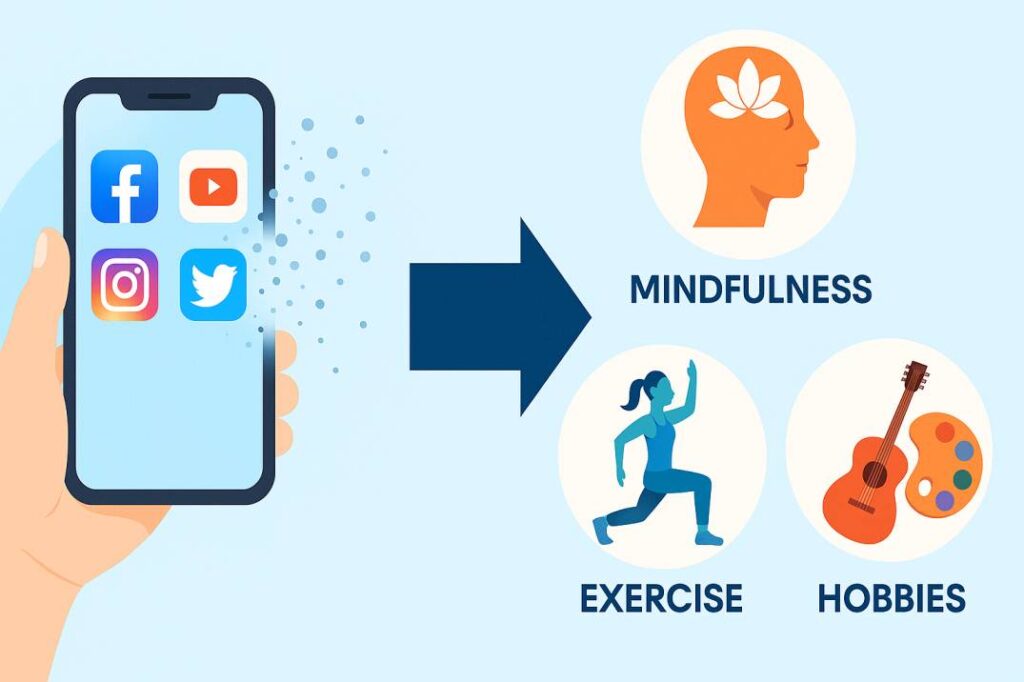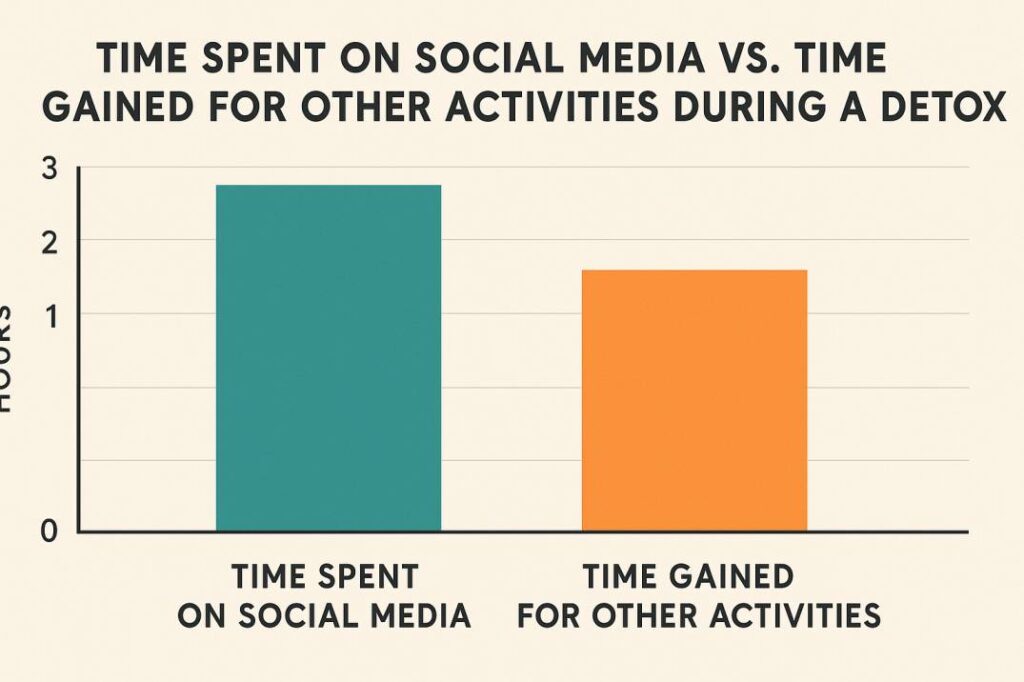Introduction
Did you know the average person spends over 2 hours daily on social media? This constant connection can overwhelm our minds, leading to stress and reduced productivity. A social media detox offers a refreshing way to reclaim your time and mental clarity in today’s hyper-digital world. This guide shows you what a social media detox is, how to start one, its stages, duration, tips, side effects, benefits, and what success feels like, empowering you to unplug with confidence.

What Is a Social Media Detox?
A social media detox is a deliberate break from platforms like Instagram, X, or TikTok to reduce digital overload and refocus on real-world connections. It’s not about quitting forever but stepping back to reset your relationship with technology.
- Why It Matters: Excessive social media use is linked to anxiety and poor sleep, according to a 2023 study by the American Psychological Association.
- Problem Solved: It frees up time for hobbies, improves focus, and boosts mental health.

How to Begin a Social Media Detox
Starting a social media detox requires intention and planning. Here’s how to do it:
Set Clear Goals
- 1: Define why you’re detoxing—less stress, more productivity, or better sleep. Clear goals keep you motivated.
- 2: Unlike vague resolutions, specific goals (e.g., “no Instagram for 7 days”) are easier to track than quitting “social media” broadly.
- Pro Tip: Write your goals in a journal to stay accountable.
Notify Your Circle
- 1: Inform friends or followers you’ll be offline to avoid FOMO or miscommunication.
- 2: This step sets boundaries, unlike unplanned breaks where people might worry about your absence.
- Pro Tip: Use an auto-reply message to manage expectations.
Remove Temptation
- 1: Delete apps or use tools like Freedom to block access temporarily.
- 2: Compared to relying on willpower, these tools create a physical barrier to mindless scrolling.
- Pro Tip: Store your phone in another room during detox hours.

Several Stages of Social Media Detox
A detox typically unfolds in three stages:
Stage 1: Withdrawal (Days 1–3)
You might feel restless or anxious without your usual scroll. This is normal as your brain adjusts to less dopamine.
Stage 2: Adjustment (Days 4–7)
You start finding alternative activities, like journaling or walking, and notice improved focus.
Stage 3: Clarity (Day 8+)
By now, you feel lighter, more present, and less dependent on digital validation.

How Long Should a Social Media Detox Last?
The ideal duration depends on your goals. A weekend detox (2–3 days) suits beginners, while a 7–14-day break offers deeper benefits. For a transformative reset, try 30 days. Studies suggest longer breaks lead to sustained habits, but start small to avoid burnout.
10 Tips for a Successful Social Media Detox
Here are 10 practical strategies to thrive during your detox:
1. Replace Scrolling with Hobbies
- 1: Fill the void with activities like painting or yoga.
- 2: Unlike passive scrolling, hobbies engage your mind actively.
- Pro Tip: Try a new skill to keep things exciting.
2. Set Specific Detox Hours
- 1: Start with evenings or weekends if a full detox feels daunting.
- 2: Partial detoxes are less intense than cold turkey.
- Pro Tip: Use a timer to enforce your offline hours.
3. Use Analog Tools
- 1: Swap digital planners for paper notebooks.
- 2: Analog tools reduce screen time compared to apps.
- Pro Tip: Carry a pocket journal for ideas.
4. Practice Mindfulness
- 1: Meditation or deep breathing curbs cravings for notifications.
- 2: Unlike distractions, mindfulness builds self-awareness.
- Pro Tip: Try a 5-minute guided meditation daily.
5. Stay Active
- Key Feature 1: Exercise boosts mood and replaces screen time.
- Key Feature 2: Physical activity trumps sedentary scrolling for energy.
- Pro Tip: Join a local sports club for social connection.
6. Limit Notifications
- 1: Turn off non-essential alerts before detoxing.
- 2: Fewer notifications mean less temptation compared to constant pings.
- Pro Tip: Keep only critical apps like messaging active.
7. Connect Offline
- 1: Meet friends or family in person to replace virtual chats.
- 2: Face-to-face bonds feel richer than likes or comments.
- Pro Tip: Plan a coffee date to stay social.
8. Track Your Progress
- 1: Log how you feel daily to stay motivated.
- 2: Tracking shows progress, unlike aimless breaks.
- Pro Tip: Use a habit tracker app sparingly.
9. Avoid Digital Substitutes
- 1: Don’t swap social media for other screens like Netflix.
- 2: True detox focuses on non-digital activities.
- Pro Tip: Read a physical book instead of e-books.
10. Reflect Post-Detox
- 1: Assess what you gained—better sleep, more time, etc.
- 2: Reflection solidifies habits, unlike jumping back online.
- Pro Tip: Journal your insights to plan future detoxes.
Social Media Detox Side Effects
You might experience irritability, boredom, or FOMO initially, as your brain craves stimulation. These fade within days. On the flip side, you may feel more focused, rested, and creative as you reconnect with yourself.

Advantages of a Social Media Detox
- Mental Clarity: Less noise improves decision-making.
- Better Relationships: More time for meaningful connections.
- Productivity Boost: Fewer distractions mean more gets done.
How Does a Successful Social Media Detox Feel?
A successful detox leaves you refreshed, empowered, and in control. You’ll likely feel less anxious, sleep better, and enjoy a renewed appreciation for offline moments, like a quiet walk or a heartfelt conversation.
The best detox approach is a 7–14-day break with clear goals and offline activities, as it balances challenge and sustainability. Beginners should start with a weekend detox, while those seeking transformation can try 30 days.
Conclusion
A social media detox is a powerful way to reclaim your time and mental peace, offering clarity and stronger real-world connections. Start small, stay intentional, and enjoy the benefits of unplugging. Which detox tip resonates with you? Share in the comments below! Also, don’t forget to discover other posts in our wellness guide.

